Commercial Law: Selecting a Business Structure for a Fashion Firm
VerifiedAdded on 2023/03/31
|7
|1683
|290
Report
AI Summary
This report provides comprehensive legal advice to Mr. John Smith regarding the optimal business structure for his planned fashion industry venture. It explores various business structures including sole proprietorships, partnerships, and companies, outlining their advantages and disadvantages. The report advises against sole proprietorships and partnerships due to unlimited liability and potential management complexities. It recommends a proprietary company structure, highlighting its limited liability protection for personal assets and sole control for the director. While acknowledging the compliance requirements and costs associated with a proprietary company, the report concludes that it offers the best balance of security and control for a small-scale fashion business. The report also touches upon tax implications and the role of ASIC in regulating company operations. Desklib provides access to similar solved assignments and study resources for students.
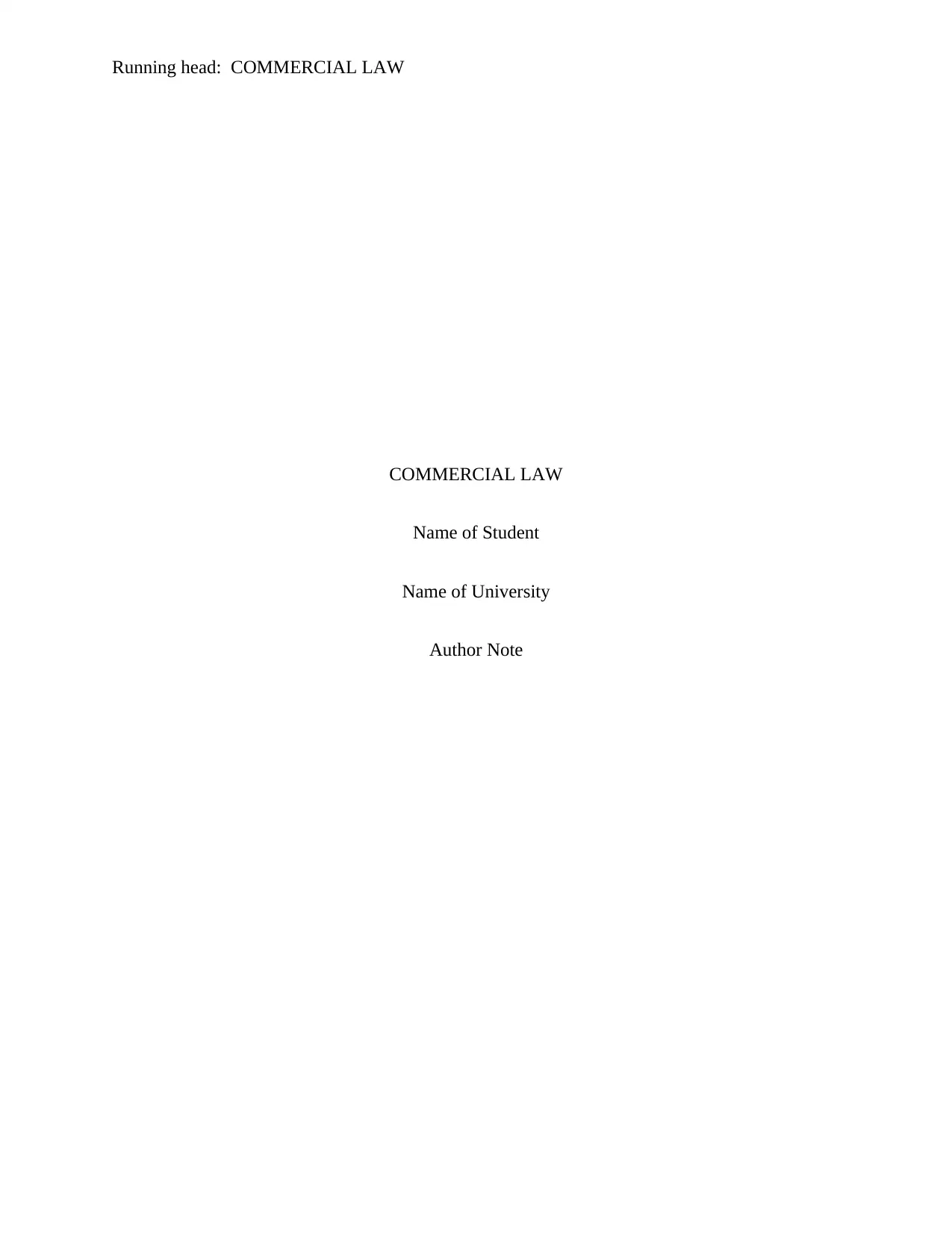
Running head: COMMERCIAL LAW
COMMERCIAL LAW
Name of Student
Name of University
Author Note
COMMERCIAL LAW
Name of Student
Name of University
Author Note
Paraphrase This Document
Need a fresh take? Get an instant paraphrase of this document with our AI Paraphraser
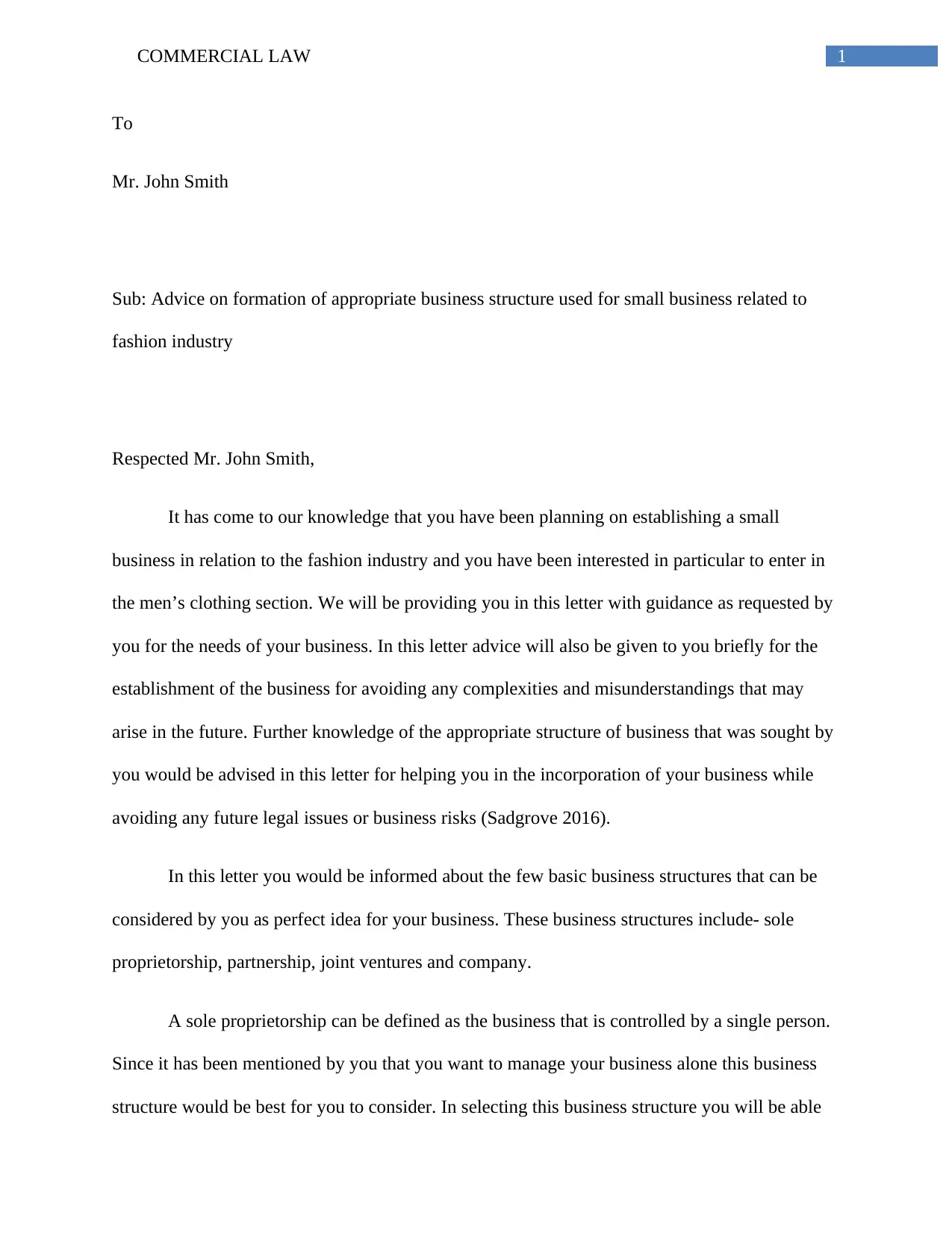
1COMMERCIAL LAW
To
Mr. John Smith
Sub: Advice on formation of appropriate business structure used for small business related to
fashion industry
Respected Mr. John Smith,
It has come to our knowledge that you have been planning on establishing a small
business in relation to the fashion industry and you have been interested in particular to enter in
the men’s clothing section. We will be providing you in this letter with guidance as requested by
you for the needs of your business. In this letter advice will also be given to you briefly for the
establishment of the business for avoiding any complexities and misunderstandings that may
arise in the future. Further knowledge of the appropriate structure of business that was sought by
you would be advised in this letter for helping you in the incorporation of your business while
avoiding any future legal issues or business risks (Sadgrove 2016).
In this letter you would be informed about the few basic business structures that can be
considered by you as perfect idea for your business. These business structures include- sole
proprietorship, partnership, joint ventures and company.
A sole proprietorship can be defined as the business that is controlled by a single person.
Since it has been mentioned by you that you want to manage your business alone this business
structure would be best for you to consider. In selecting this business structure you will be able
To
Mr. John Smith
Sub: Advice on formation of appropriate business structure used for small business related to
fashion industry
Respected Mr. John Smith,
It has come to our knowledge that you have been planning on establishing a small
business in relation to the fashion industry and you have been interested in particular to enter in
the men’s clothing section. We will be providing you in this letter with guidance as requested by
you for the needs of your business. In this letter advice will also be given to you briefly for the
establishment of the business for avoiding any complexities and misunderstandings that may
arise in the future. Further knowledge of the appropriate structure of business that was sought by
you would be advised in this letter for helping you in the incorporation of your business while
avoiding any future legal issues or business risks (Sadgrove 2016).
In this letter you would be informed about the few basic business structures that can be
considered by you as perfect idea for your business. These business structures include- sole
proprietorship, partnership, joint ventures and company.
A sole proprietorship can be defined as the business that is controlled by a single person.
Since it has been mentioned by you that you want to manage your business alone this business
structure would be best for you to consider. In selecting this business structure you will be able
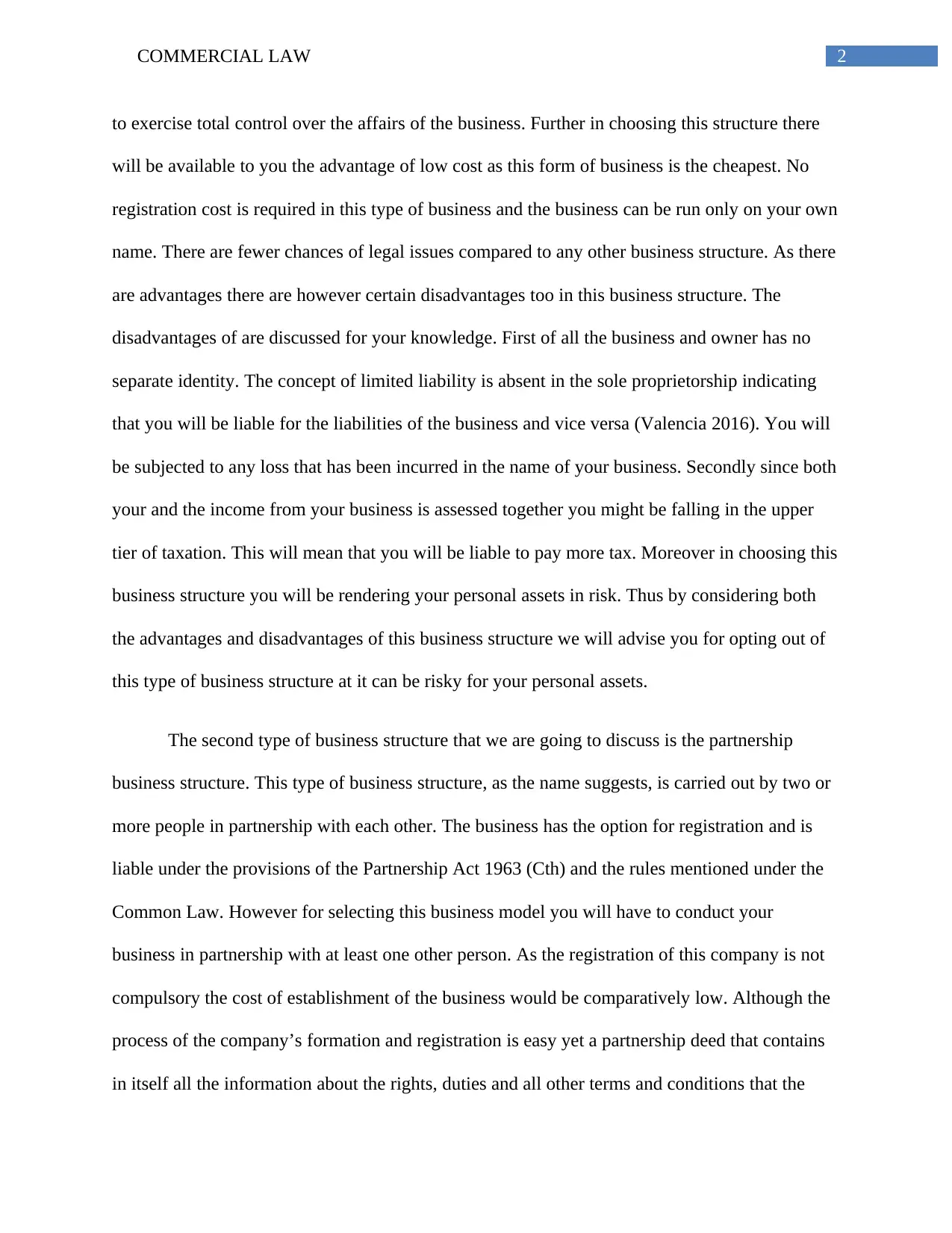
2COMMERCIAL LAW
to exercise total control over the affairs of the business. Further in choosing this structure there
will be available to you the advantage of low cost as this form of business is the cheapest. No
registration cost is required in this type of business and the business can be run only on your own
name. There are fewer chances of legal issues compared to any other business structure. As there
are advantages there are however certain disadvantages too in this business structure. The
disadvantages of are discussed for your knowledge. First of all the business and owner has no
separate identity. The concept of limited liability is absent in the sole proprietorship indicating
that you will be liable for the liabilities of the business and vice versa (Valencia 2016). You will
be subjected to any loss that has been incurred in the name of your business. Secondly since both
your and the income from your business is assessed together you might be falling in the upper
tier of taxation. This will mean that you will be liable to pay more tax. Moreover in choosing this
business structure you will be rendering your personal assets in risk. Thus by considering both
the advantages and disadvantages of this business structure we will advise you for opting out of
this type of business structure at it can be risky for your personal assets.
The second type of business structure that we are going to discuss is the partnership
business structure. This type of business structure, as the name suggests, is carried out by two or
more people in partnership with each other. The business has the option for registration and is
liable under the provisions of the Partnership Act 1963 (Cth) and the rules mentioned under the
Common Law. However for selecting this business model you will have to conduct your
business in partnership with at least one other person. As the registration of this company is not
compulsory the cost of establishment of the business would be comparatively low. Although the
process of the company’s formation and registration is easy yet a partnership deed that contains
in itself all the information about the rights, duties and all other terms and conditions that the
to exercise total control over the affairs of the business. Further in choosing this structure there
will be available to you the advantage of low cost as this form of business is the cheapest. No
registration cost is required in this type of business and the business can be run only on your own
name. There are fewer chances of legal issues compared to any other business structure. As there
are advantages there are however certain disadvantages too in this business structure. The
disadvantages of are discussed for your knowledge. First of all the business and owner has no
separate identity. The concept of limited liability is absent in the sole proprietorship indicating
that you will be liable for the liabilities of the business and vice versa (Valencia 2016). You will
be subjected to any loss that has been incurred in the name of your business. Secondly since both
your and the income from your business is assessed together you might be falling in the upper
tier of taxation. This will mean that you will be liable to pay more tax. Moreover in choosing this
business structure you will be rendering your personal assets in risk. Thus by considering both
the advantages and disadvantages of this business structure we will advise you for opting out of
this type of business structure at it can be risky for your personal assets.
The second type of business structure that we are going to discuss is the partnership
business structure. This type of business structure, as the name suggests, is carried out by two or
more people in partnership with each other. The business has the option for registration and is
liable under the provisions of the Partnership Act 1963 (Cth) and the rules mentioned under the
Common Law. However for selecting this business model you will have to conduct your
business in partnership with at least one other person. As the registration of this company is not
compulsory the cost of establishment of the business would be comparatively low. Although the
process of the company’s formation and registration is easy yet a partnership deed that contains
in itself all the information about the rights, duties and all other terms and conditions that the
⊘ This is a preview!⊘
Do you want full access?
Subscribe today to unlock all pages.

Trusted by 1+ million students worldwide
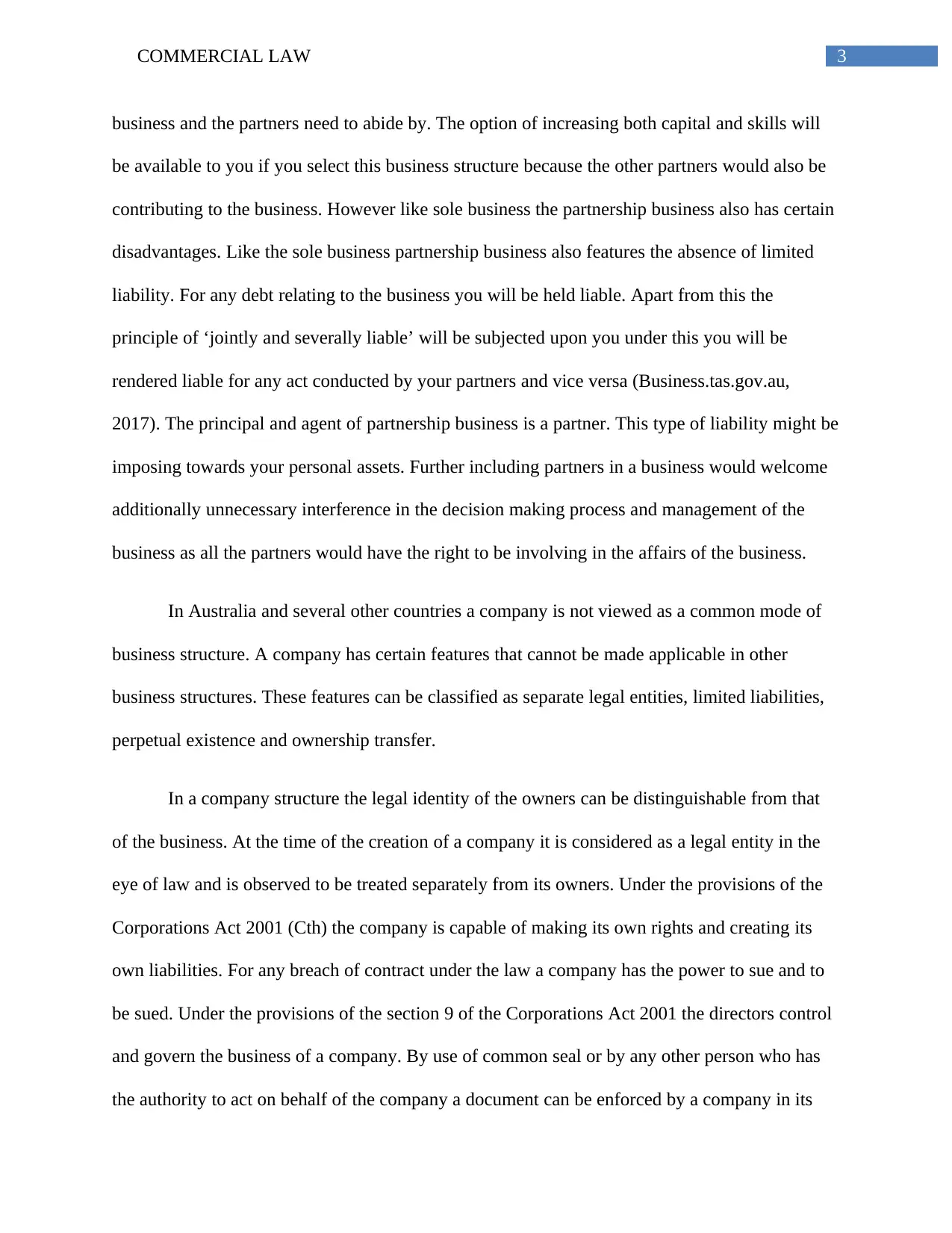
3COMMERCIAL LAW
business and the partners need to abide by. The option of increasing both capital and skills will
be available to you if you select this business structure because the other partners would also be
contributing to the business. However like sole business the partnership business also has certain
disadvantages. Like the sole business partnership business also features the absence of limited
liability. For any debt relating to the business you will be held liable. Apart from this the
principle of ‘jointly and severally liable’ will be subjected upon you under this you will be
rendered liable for any act conducted by your partners and vice versa (Business.tas.gov.au,
2017). The principal and agent of partnership business is a partner. This type of liability might be
imposing towards your personal assets. Further including partners in a business would welcome
additionally unnecessary interference in the decision making process and management of the
business as all the partners would have the right to be involving in the affairs of the business.
In Australia and several other countries a company is not viewed as a common mode of
business structure. A company has certain features that cannot be made applicable in other
business structures. These features can be classified as separate legal entities, limited liabilities,
perpetual existence and ownership transfer.
In a company structure the legal identity of the owners can be distinguishable from that
of the business. At the time of the creation of a company it is considered as a legal entity in the
eye of law and is observed to be treated separately from its owners. Under the provisions of the
Corporations Act 2001 (Cth) the company is capable of making its own rights and creating its
own liabilities. For any breach of contract under the law a company has the power to sue and to
be sued. Under the provisions of the section 9 of the Corporations Act 2001 the directors control
and govern the business of a company. By use of common seal or by any other person who has
the authority to act on behalf of the company a document can be enforced by a company in its
business and the partners need to abide by. The option of increasing both capital and skills will
be available to you if you select this business structure because the other partners would also be
contributing to the business. However like sole business the partnership business also has certain
disadvantages. Like the sole business partnership business also features the absence of limited
liability. For any debt relating to the business you will be held liable. Apart from this the
principle of ‘jointly and severally liable’ will be subjected upon you under this you will be
rendered liable for any act conducted by your partners and vice versa (Business.tas.gov.au,
2017). The principal and agent of partnership business is a partner. This type of liability might be
imposing towards your personal assets. Further including partners in a business would welcome
additionally unnecessary interference in the decision making process and management of the
business as all the partners would have the right to be involving in the affairs of the business.
In Australia and several other countries a company is not viewed as a common mode of
business structure. A company has certain features that cannot be made applicable in other
business structures. These features can be classified as separate legal entities, limited liabilities,
perpetual existence and ownership transfer.
In a company structure the legal identity of the owners can be distinguishable from that
of the business. At the time of the creation of a company it is considered as a legal entity in the
eye of law and is observed to be treated separately from its owners. Under the provisions of the
Corporations Act 2001 (Cth) the company is capable of making its own rights and creating its
own liabilities. For any breach of contract under the law a company has the power to sue and to
be sued. Under the provisions of the section 9 of the Corporations Act 2001 the directors control
and govern the business of a company. By use of common seal or by any other person who has
the authority to act on behalf of the company a document can be enforced by a company in its
Paraphrase This Document
Need a fresh take? Get an instant paraphrase of this document with our AI Paraphraser
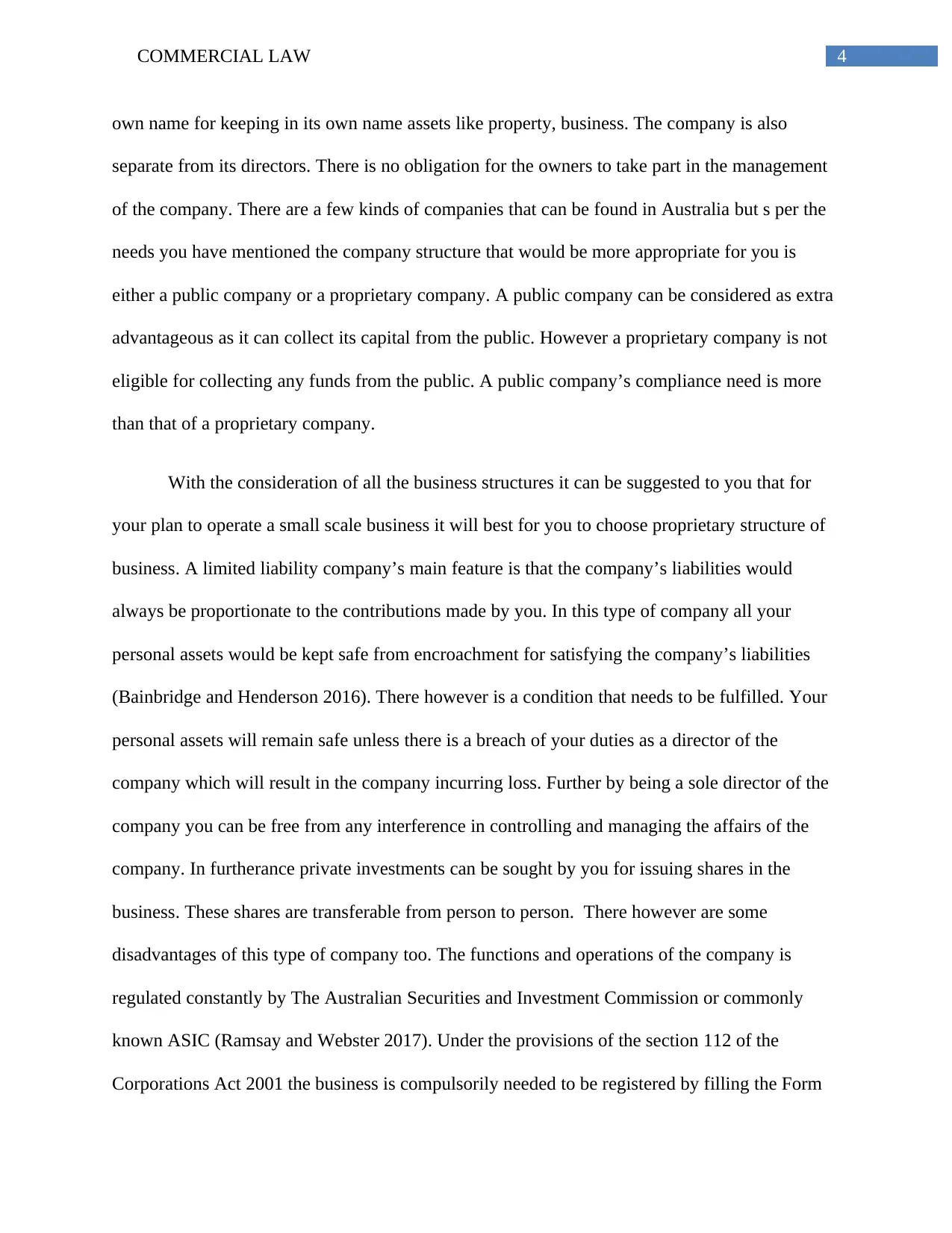
4COMMERCIAL LAW
own name for keeping in its own name assets like property, business. The company is also
separate from its directors. There is no obligation for the owners to take part in the management
of the company. There are a few kinds of companies that can be found in Australia but s per the
needs you have mentioned the company structure that would be more appropriate for you is
either a public company or a proprietary company. A public company can be considered as extra
advantageous as it can collect its capital from the public. However a proprietary company is not
eligible for collecting any funds from the public. A public company’s compliance need is more
than that of a proprietary company.
With the consideration of all the business structures it can be suggested to you that for
your plan to operate a small scale business it will best for you to choose proprietary structure of
business. A limited liability company’s main feature is that the company’s liabilities would
always be proportionate to the contributions made by you. In this type of company all your
personal assets would be kept safe from encroachment for satisfying the company’s liabilities
(Bainbridge and Henderson 2016). There however is a condition that needs to be fulfilled. Your
personal assets will remain safe unless there is a breach of your duties as a director of the
company which will result in the company incurring loss. Further by being a sole director of the
company you can be free from any interference in controlling and managing the affairs of the
company. In furtherance private investments can be sought by you for issuing shares in the
business. These shares are transferable from person to person. There however are some
disadvantages of this type of company too. The functions and operations of the company is
regulated constantly by The Australian Securities and Investment Commission or commonly
known ASIC (Ramsay and Webster 2017). Under the provisions of the section 112 of the
Corporations Act 2001 the business is compulsorily needed to be registered by filling the Form
own name for keeping in its own name assets like property, business. The company is also
separate from its directors. There is no obligation for the owners to take part in the management
of the company. There are a few kinds of companies that can be found in Australia but s per the
needs you have mentioned the company structure that would be more appropriate for you is
either a public company or a proprietary company. A public company can be considered as extra
advantageous as it can collect its capital from the public. However a proprietary company is not
eligible for collecting any funds from the public. A public company’s compliance need is more
than that of a proprietary company.
With the consideration of all the business structures it can be suggested to you that for
your plan to operate a small scale business it will best for you to choose proprietary structure of
business. A limited liability company’s main feature is that the company’s liabilities would
always be proportionate to the contributions made by you. In this type of company all your
personal assets would be kept safe from encroachment for satisfying the company’s liabilities
(Bainbridge and Henderson 2016). There however is a condition that needs to be fulfilled. Your
personal assets will remain safe unless there is a breach of your duties as a director of the
company which will result in the company incurring loss. Further by being a sole director of the
company you can be free from any interference in controlling and managing the affairs of the
company. In furtherance private investments can be sought by you for issuing shares in the
business. These shares are transferable from person to person. There however are some
disadvantages of this type of company too. The functions and operations of the company is
regulated constantly by The Australian Securities and Investment Commission or commonly
known ASIC (Ramsay and Webster 2017). Under the provisions of the section 112 of the
Corporations Act 2001 the business is compulsorily needed to be registered by filling the Form
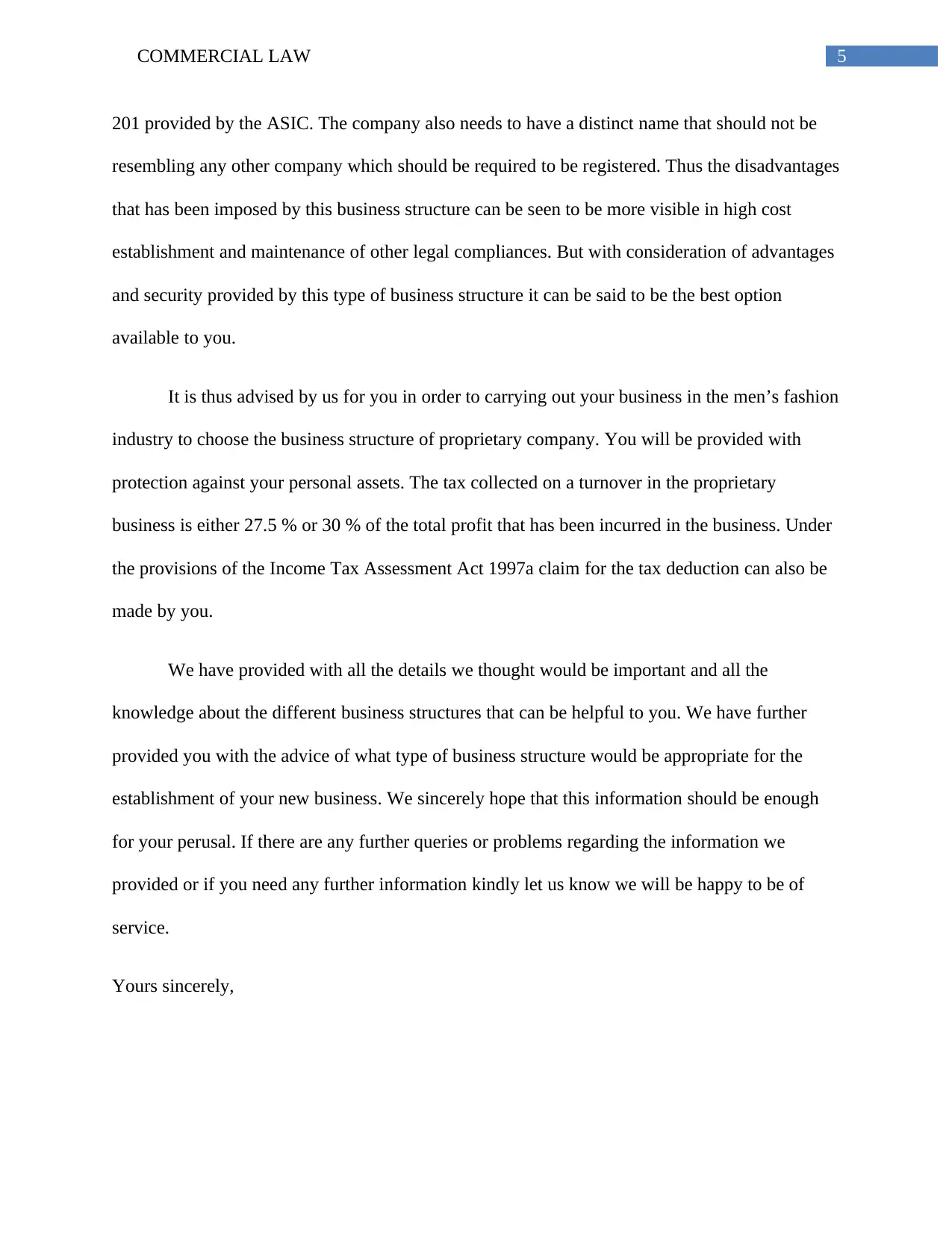
5COMMERCIAL LAW
201 provided by the ASIC. The company also needs to have a distinct name that should not be
resembling any other company which should be required to be registered. Thus the disadvantages
that has been imposed by this business structure can be seen to be more visible in high cost
establishment and maintenance of other legal compliances. But with consideration of advantages
and security provided by this type of business structure it can be said to be the best option
available to you.
It is thus advised by us for you in order to carrying out your business in the men’s fashion
industry to choose the business structure of proprietary company. You will be provided with
protection against your personal assets. The tax collected on a turnover in the proprietary
business is either 27.5 % or 30 % of the total profit that has been incurred in the business. Under
the provisions of the Income Tax Assessment Act 1997a claim for the tax deduction can also be
made by you.
We have provided with all the details we thought would be important and all the
knowledge about the different business structures that can be helpful to you. We have further
provided you with the advice of what type of business structure would be appropriate for the
establishment of your new business. We sincerely hope that this information should be enough
for your perusal. If there are any further queries or problems regarding the information we
provided or if you need any further information kindly let us know we will be happy to be of
service.
Yours sincerely,
201 provided by the ASIC. The company also needs to have a distinct name that should not be
resembling any other company which should be required to be registered. Thus the disadvantages
that has been imposed by this business structure can be seen to be more visible in high cost
establishment and maintenance of other legal compliances. But with consideration of advantages
and security provided by this type of business structure it can be said to be the best option
available to you.
It is thus advised by us for you in order to carrying out your business in the men’s fashion
industry to choose the business structure of proprietary company. You will be provided with
protection against your personal assets. The tax collected on a turnover in the proprietary
business is either 27.5 % or 30 % of the total profit that has been incurred in the business. Under
the provisions of the Income Tax Assessment Act 1997a claim for the tax deduction can also be
made by you.
We have provided with all the details we thought would be important and all the
knowledge about the different business structures that can be helpful to you. We have further
provided you with the advice of what type of business structure would be appropriate for the
establishment of your new business. We sincerely hope that this information should be enough
for your perusal. If there are any further queries or problems regarding the information we
provided or if you need any further information kindly let us know we will be happy to be of
service.
Yours sincerely,
⊘ This is a preview!⊘
Do you want full access?
Subscribe today to unlock all pages.

Trusted by 1+ million students worldwide
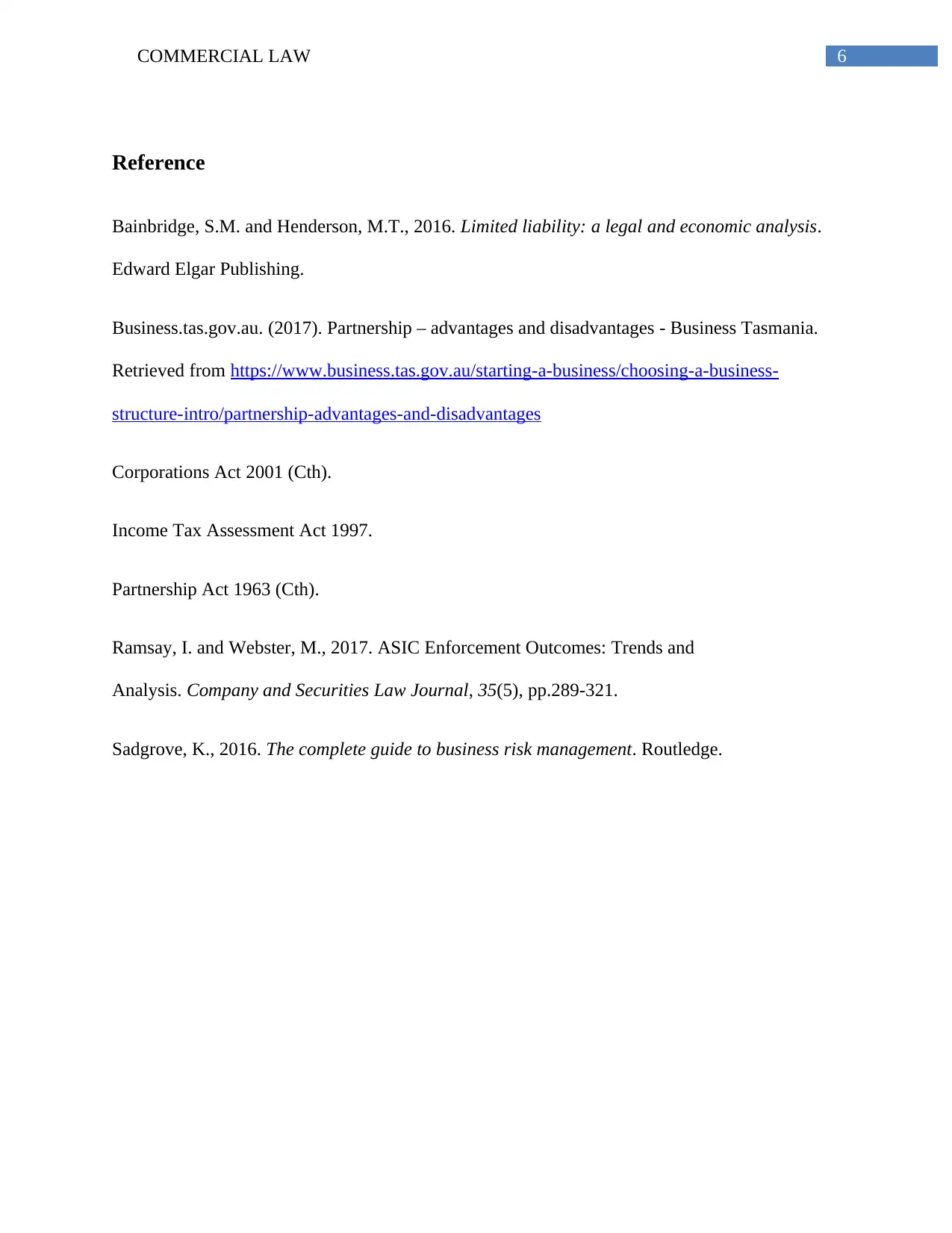
6COMMERCIAL LAW
Reference
Bainbridge, S.M. and Henderson, M.T., 2016. Limited liability: a legal and economic analysis.
Edward Elgar Publishing.
Business.tas.gov.au. (2017). Partnership – advantages and disadvantages - Business Tasmania.
Retrieved from https://www.business.tas.gov.au/starting-a-business/choosing-a-business-
structure-intro/partnership-advantages-and-disadvantages
Corporations Act 2001 (Cth).
Income Tax Assessment Act 1997.
Partnership Act 1963 (Cth).
Ramsay, I. and Webster, M., 2017. ASIC Enforcement Outcomes: Trends and
Analysis. Company and Securities Law Journal, 35(5), pp.289-321.
Sadgrove, K., 2016. The complete guide to business risk management. Routledge.
Reference
Bainbridge, S.M. and Henderson, M.T., 2016. Limited liability: a legal and economic analysis.
Edward Elgar Publishing.
Business.tas.gov.au. (2017). Partnership – advantages and disadvantages - Business Tasmania.
Retrieved from https://www.business.tas.gov.au/starting-a-business/choosing-a-business-
structure-intro/partnership-advantages-and-disadvantages
Corporations Act 2001 (Cth).
Income Tax Assessment Act 1997.
Partnership Act 1963 (Cth).
Ramsay, I. and Webster, M., 2017. ASIC Enforcement Outcomes: Trends and
Analysis. Company and Securities Law Journal, 35(5), pp.289-321.
Sadgrove, K., 2016. The complete guide to business risk management. Routledge.
1 out of 7
Related Documents
Your All-in-One AI-Powered Toolkit for Academic Success.
+13062052269
info@desklib.com
Available 24*7 on WhatsApp / Email
![[object Object]](/_next/static/media/star-bottom.7253800d.svg)
Unlock your academic potential
Copyright © 2020–2025 A2Z Services. All Rights Reserved. Developed and managed by ZUCOL.



